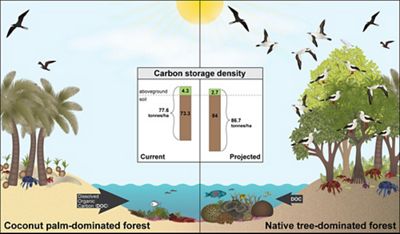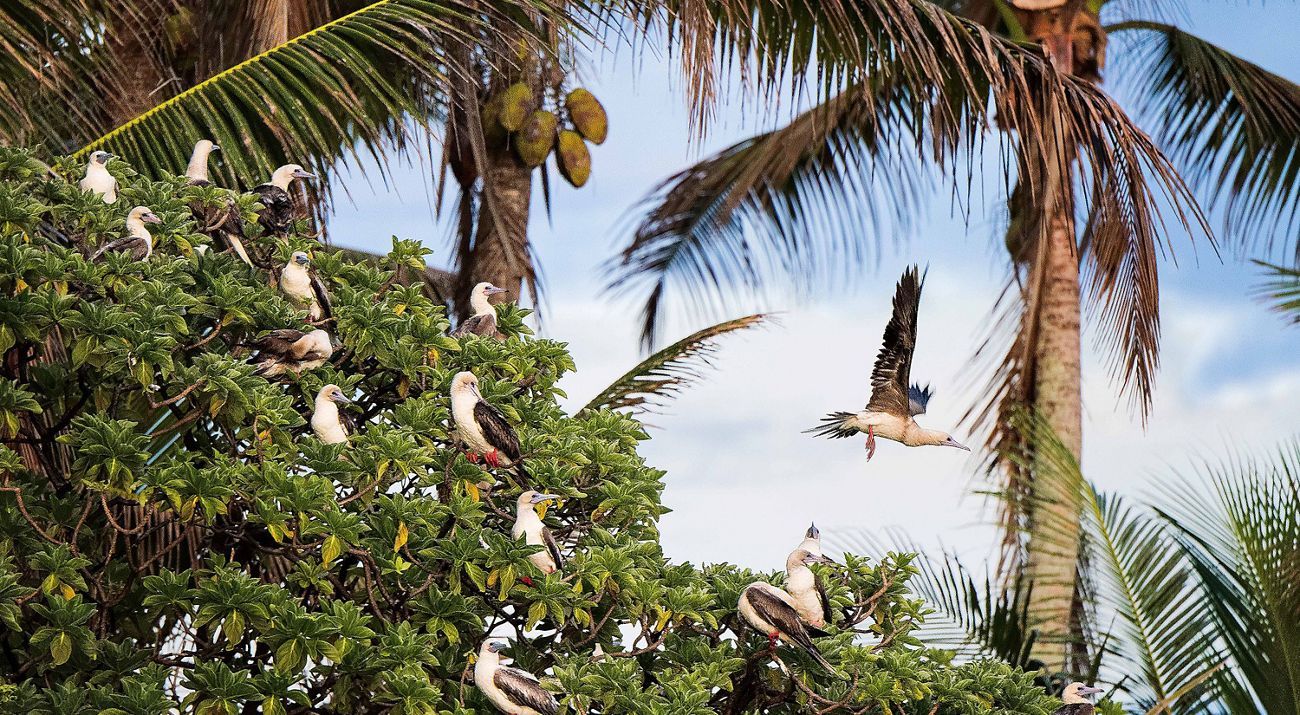New Study by The Nature Conservancy Shows that Restoring Native Trees Increases Carbon Capture
Media Contacts
-
Evelyn Wight
The Nature Conservancy
Phone: 808-587-6277
Email: ewight@tnc.org
Research conducted by The Nature Conservancy (TNC) and published last month in the journal PLoS ONE finds that native trees capture more carbon than introduced palms at Palmyra Atoll. The study measured the carbon impact of replacing the non-native palms that cover more than 40% of the atoll with native rainforest trees preferred by seabirds and found that restoring the atoll to native tree dominance not only stores more carbon, but also enhances biodiversity and reduces disease risk for corals.
This is the first known effort to calculate the carbon stored by vegetation for an entire tropical atoll. In addition to capturing more carbon, native trees were found to decrease the amount of dissolved organic carbon (DOC) going from the soil into the ocean, which benefits coral reefs (too much DOC can cause disease outbreaks and degrade reefs).
“We’ve demonstrated that better stewardship of natural resources can increase their carbon capture ability,” says first author Kate Longley-Wood, Ocean Mapping Coordinator with TNC’s Protect Oceans, Lands and Waters program. “That native tree species are better for carbon capture and ocean health is the icing on the cake. These findings can help managers elsewhere understand how native forest restoration can increase the carbon capture potential and other benefits of their projects.”

“Capturing carbon is an important global need as the earth navigates toward a possible temperature increase of 2 degrees Celsius,” says Alex Wegmann, TNC Senior Scientist and co-author of the paper. “Natural Climate Solutions like forest restoration can increase carbon capture while improving the overall health of the island and nearshore marine ecosystem. This study provides further incentive to consider forest restoration on islands and atolls as a land-to-sea conservation solution,” says Wegmann.
###
The Nature Conservancy is a global non-profit organization dedicated to conserving the lands and waters on which all life depends. Informed by science and guided by traditional values and practices, we apply innovative, nature-based solutions to our world’s toughest challenges so that nature and people can thrive. TNC has forged partnerships to manage 14 preserves and other sites in Hawai‘i and Palmyra Atoll, working with government, private parties and communities to protect Hawai‘i’s and Palmyra’s forests and coral reefs for their ecological value and for the many benefits they provide to people. Visit nature.org/HawaiiPalmyra.
The Nature Conservancy is a global conservation organization dedicated to conserving the lands and waters on which all life depends. Guided by science, we create innovative, on-the-ground solutions to our world’s toughest challenges so that nature and people can thrive together. We are tackling climate change, conserving lands, waters and oceans at an unprecedented scale, providing food and water sustainably and helping make cities more resilient. The Nature Conservancy is working to make a lasting difference around the world in 81 countries and territories (40 by direct conservation impact and 41 through partners) through a collaborative approach that engages local communities, governments, the private sector, and other partners. To learn more, visit nature.org or follow @nature_press on X.
